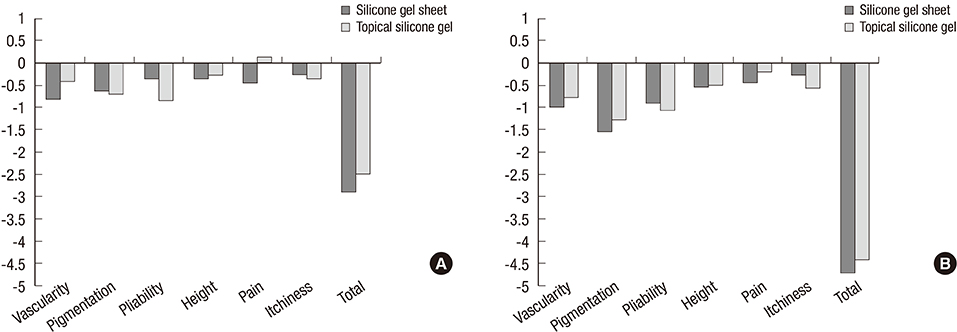J Korean Med Sci.
2014 Nov;29(Suppl 3):S249-S253. 10.3346/jkms.2014.29.S3.S249.
Prevention of Postsurgical Scars: Comparsion of Efficacy and Convenience between Silicone Gel Sheet and Topical Silicone Gel
- Affiliations
-
- 1Department of Plastic & Reconstructive Surgery, Bucheon St. Mary's Hospital, The Catholic University of Korea, Bucheon, Korea. joony@catholic.ac.kr
- KMID: 2151420
- DOI: http://doi.org/10.3346/jkms.2014.29.S3.S249
Abstract
- To date, few studies have compared the effectiveness of topical silicone gels versus that of silicone gel sheets in preventing scars. In this prospective study, we compared the efficacy and the convenience of use of the 2 products. We enrolled 30 patients who had undergone a surgical procedure 2 weeks to 3 months before joining the study. These participants were randomly assigned to 2 treatment arms: one for treatment with a silicone gel sheet, and the other for treatment with a topical silicone gel. Vancouver Scar Scale (VSS) scores were obtained for all patients; in addition, participants completed scoring patient questionnaires 1 and 3 months after treatment onset. Our results reveal not only that no significant difference in efficacy exists between the 2 products but also that topical silicone gels are more convenient to use. While previous studies have advocated for silicone gel sheets as first-line therapies in postoperative scar management, we maintain that similar effects can be expected with topical silicone gel. The authors recommend that, when clinicians have a choice of silicone-based products for scar prevention, they should focus on each patient's scar location, lifestyle, and willingness to undergo scar prevention treatment.
MeSH Terms
-
Adult
Aged
Cicatrix/*prevention & control
Female
Humans
Male
Middle Aged
Postoperative Period
Prospective Studies
Questionnaires
Random Allocation
Silicone Gels/*administration & dosage/*pharmacology
Surgery, Plastic/*methods
Surgical Procedures, Operative/*adverse effects
Wounds and Injuries/therapy
Young Adult
Silicone Gels
Figure
Reference
-
1. Ahn ST, Monafo WW, Mustoe TA. Topical silicone gel for the prevention and treatment of hypertrophic scar. Arch Surg. 1991; 126:499–504.2. Cruz-Korchin NI. Effectiveness of silicone sheets in the prevention of hypertrophic breast scars. Ann Plast Surg. 1996; 37:345–348.3. Mustoe TA. Evolution of silicone therapy and mechanism of action in scar management. Aesthetic Plast Surg. 2008; 32:82–92.4. Signorini M, Clementoni MT. Clinical evaluation of a new self-drying silicone gel in the treatment of scars: a preliminary report. Aesthetic Plast Surg. 2007; 31:183–187.5. Gimble J, Guilak F. Adipose-derived adult stem cells: isolation, characterization, and differentiation potential. Cytotherapy. 2003; 5:362–369.6. Bae SH, Bae YC. Analysis of frequency of use of different scar assessment scales based on the scar condition and treatment method. Arch Plast Surg. 2014; 41:111–115.7. Ko WJ, Na YC, Suh BS, Kim HA, Heo WH, Choi GH, Lee SU. The effects of topical agent (kelo-cote or contractubex) massage on the thickness of post-burn scar tissue formed in rats. Arch Plast Surg. 2013; 40:697–704.8. Karagoz H, Yuksel F, Ulkur E, Evinc R. Comparison of efficacy of silicone gel, silicone gel sheeting, and topical onion extract including heparin and allantoin for the treatment of postburn hypertrophic scars. Burns. 2009; 35:1097–1103.9. Di Rocco G, Gentile A, Antonini A, Ceradini F, Wu JC, Capogrossi MC, Toietta G. Enhanced healing of diabetic wounds by topical administration of adipose tissue-derived stromal cells overexpressing stromal-derived factor-1: biodistribution and engraftment analysis by bioluminescent imaging. Stem Cells Int. 2010; 2011:304562.10. Shih R, Waltzman J, Evans GR. Plastic Surgery Educational Foundation Technology Assessment Committee. Review of over-the-counter topical scar treatment products. Plast Reconstr Surg. 2007; 119:1091–1095.11. Reish RG, Eriksson E. Scars: a review of emerging and currently available therapies. Plast Reconstr Surg. 2008; 122:1068–1078.12. Stavrou D, Weissman O, Winkler E, Yankelson L, Millet E, Mushin OP, Liran A, Haik J. Silicone-based scar therapy: a review of the literature. Aesthetic Plast Surg. 2010; 34:646–651.13. Berman B, Perez OA, Konda S, Kohut BE, Viera MH, Delgado S, Zell D, Li Q. A review of the biologic effects, clinical efficacy, and safety of silicone elastomer sheeting for hypertrophic and keloid scar treatment and management. Dermatol Surg. 2007; 33:1291–1302. discussion 1302-3.14. Perkins K, Davey RB, Wallis KA. Silicone gel: a new treatment for burn scars and contractures. Burns Incl Therm Inj. 1983; 9:201–204.15. Mustoe TA, Cooter RD, Gold MH, Hobbs FD, Ramelet AA, Shakespeare PG, Stella M, Téot L, Wood FM, Ziegler UE, et al. International clinical recommendations on scar management. Plast Reconstr Surg. 2002; 110:560–571.16. Kim SW, Kim DY, Oh DY, Lee JH, Rhie JW, Ahn ST, Yoon JH. Use of a silicone gel sheet vaginal mold in McIndoe vaginoplasty. Arch Plast Surg. 2013; 40:652–655.17. Martins-Mendes D, Monteiro-Soares M, Boyko EJ, Ribeiro M, Barata P, Lima J, Soares R. The independent contribution of diabetic foot ulcer on lower extremity amputation and mortality risk. J Diabetes Complications. 2014; 28:632–638.18. O'Brien L, Pandit A. Silicon gel sheeting for preventing and treating hypertrophic and keloid scars. Cochrane Database Syst Rev. 2006; CD003826.19. Chan KY, Lau CL, Adeeb SM, Somasundaram S, Nasir-Zahari M. A randomized, placebo-controlled, double-blind, prospective clinical trial of silicone gel in prevention of hypertrophic scar development in median sternotomy wound. Plast Reconstr Surg. 2005; 116:1013–1020. discussion 1021-2.20. Chernoff WG, Cramer H, Su-Huang S. The efficacy of topical silicone gel elastomers in the treatment of hypertrophic scars, keloid scars, and post-laser exfoliation erythema. Aesthetic Plast Surg. 2007; 31:495–500.21. Murison M, James W. Preliminary evaluation of the efficacy of dermatix silicone gel in the reduction of scar elevation and pigmentation. J Plast Reconstr Aesthet Surg. 2006; 59:437–439.
- Full Text Links
- Actions
-
Cited
- CITED
-
- Close
- Share
- Similar articles
-
- A Study for skin hypersensitivity of silicone Gel sheet by skin patch test
- Efficacy of Tie-over Dressing Using Silicone Gel Sheet in Skin Graft on Flat Surface
- Comparison of the effect of silicone gel sheets by thickness on excisional scars in pediatric and adolescent patients
- Regulation of Transforming Growth Factor beta1, Platelet-Derived Growth Factor, and Basic Fibroblast Growth Factor by Silicone Gel Sheeting in Early-Stage Scarring
- Reoperative Augmentation Mammoplasty of Saline Implants with Cohesive Silicone Gel Implants: A Personal Review




